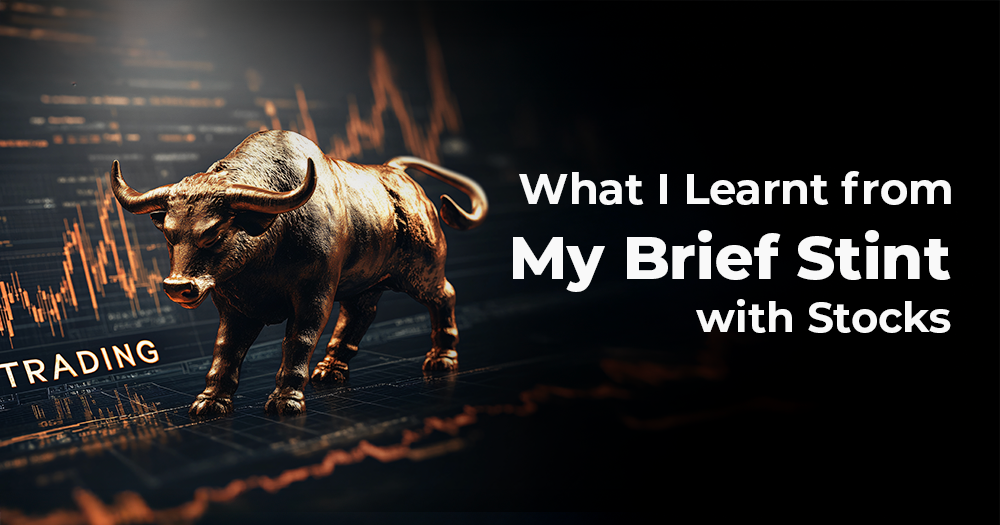My early memories of my father are inextricably linked to sound. As a toddler, it was the jangling of his keys as he arrived home after a long day at work. As a child, it was him humming along to old Bollywood songs between patients’ appointments at his clinic, while I sat beside him and finished my homework. In my teenage years, it was the pleasant clatter of him making tea in the morning as he flipped through business news channels and tuned into stock market updates.
My younger self would never have imagined that I’d replicate my father’s routines later in life. But at 27, when my income started growing steadily, I decided to try my hand at stock market investing — something that came instinctively to my father but eluded me entirely.
In my early twenties, when I was a junior editor in a fast-paced newsroom, the very idea of saving money was either a distant reality or a goal that I did not consider seriously enough.
Now, I found myself watching the news before the market’s opening bell and actually reading the countless business newsletters I’d subscribed to. Every day, I’d set aside time to evaluate my holdings and determine if they were worth retaining, and plan future purchases. Only my close friends know that I may have relied a tad too much on movies about the stock market to learn, fervidly looking up complicated financial terms and gasping at the inconceivable figures and statistics on the screen.
One morning, between looking at my watchlist of stocks and bemoaning my tea going cold, I realised I’d turned into my father.
Making my first pick of shares was equal parts thrilling and overwhelming. I decided to play it safe and bought the shares of evergreen, trusted companies — a multinational paint business, a conglomerate in energy and telecommunications. These were the same stocks that my grandparents invested in 50 years ago, when these businesses enjoyed their first decades of success.
In conversations with my friends and on social media, the chatter would often be about a flashy new startup listing its initial public offering (IPO), or young companies making a killing in the retail market. My dad, in contrast, seemed like an insider who looked past the eye-grabbing headlines, but was still willing to take risks.
At the beginning, I wondered why my appetite for risk was so low — I wasn’t being adventurous. I wondered if this had to do with my slow approach to investing in general. It had been only two years since I began to actively track bank interest rates and pick out equity and small-cap mutual funds. If my portfolio of investments wasn’t diverse, it was because of my hesitation to experiment. Even when I ventured into stocks, the idea was that I would not put more than a month’s earnings at risk.
Something shifted in me the first time I made five hundred rupees on a trade — a miniscule amount for any seasoned trader but affirming for the unacquainted. When I made my second significant trade, I called my father, who was characteristically succinct, as he is known to be when he feels excited. Over the next few months, in text conversations where we’d check up on each other, he began sending me investing tips — across gold, equity and exchange-traded funds — interjected by emojis and a joke-cum-reminder about filing my taxes on time. Today, when we discuss our finances, I know that my father sees me often as a student, and sometimes, as an equal with her own opinions and learnings.
My foray into stock market investing lasted all of two months. On good days, I would notice details and capitalise on them, such as buying the shares of a make-up marketplace before its annual blowout sale. On bad days, when I was neck-deep in an essay or chasing sources, I failed to sell certain shares before a dip in their prices had been predicted. Perhaps I could’ve asked my father for stock tips, but that would mean this was no longer a self-led endeavour.
I thought staying put wouldn’t just be the more stubborn choice, it could have resulted in more losses than profits. My father had a more encouraging view: That in the future, I will be capable of weathering the ups and downs if I had my eyes on the long-term gains.
When it comes to ‘investing for young women’, videos by financial experts and wealth managers tend to focus on the essentials, such as building an emergency fund, buying health insurance and bookmarking tax-saving instruments; they tend not to mention the stock market or other high-risk options.
Capital gains and returns aside, my decision to invest in an entirely new asset class — like my first successful trade — affirmed my belief in my own intuition and ability.
Neerja Deodhar is an independent writer and researcher based in Mumbai.







